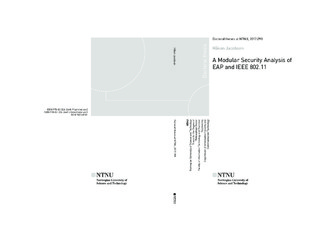| dc.description.abstract | This thesis presents a computational reduction-based security analysis of the
Extensible Authentication Protocol (EAP) and the IEEE 802.11 protocol. EAP
is a widely used authentication framework while IEEE 802.11 is the most commonly
used standard for creating wireless local area networks (WLANs), better
known as Wi-Fi. The typical use case of EAP is to allow a client on a WLAN to
connect to an access point through the use of mutually trusted server. EAP is
a general framework that specifies how different sub-protocols can be combined
to securely achieve this goal. IEEE 802.11 is usually one of the sub-protocols
used within the EAP framework.
There are three main contributions of this thesis. The first is a modular
security analysis of the general EAP framework. This includes two generic
composition theorems that reflect the modular nature of EAP, and which establish
sufficient criteria on its sub-protocols in order for the whole framework
to be instantiated securely. Having proven the soundness of the general EAP
framework, it remains to find suitable sub-protocols that satisfy the security
criteria of the composition results.
Our second main contribution is a security analysis of one such concrete subprotocol,
namely the EAP-TLS protocol which is used to establish a shared key
between the wireless client and the trusted server. We prove that EAP-TLS is
a secure two-party authenticated key exchange protocol by presenting a generic
compiler that transforms secure channel protocols into secure key exchange
protocols.
Our third main contribution is a thorough security analysis of the IEEE
802.11 protocol. We study both the handshake protocol as well as the encryption
algorithm used to protect the application data. On their own, our results
on IEEE 802.11 apply to the usage found in wireless home networks where a
key is shared between the client and access point a priori, e.g. using a password.
However, by combining this with our composition theorems for the EAP
framework, we also obtain a result for IEEE 802.11 in its “enterprise” variant,
where the common key is instead established using a mutually trusted server. | nb_NO |
